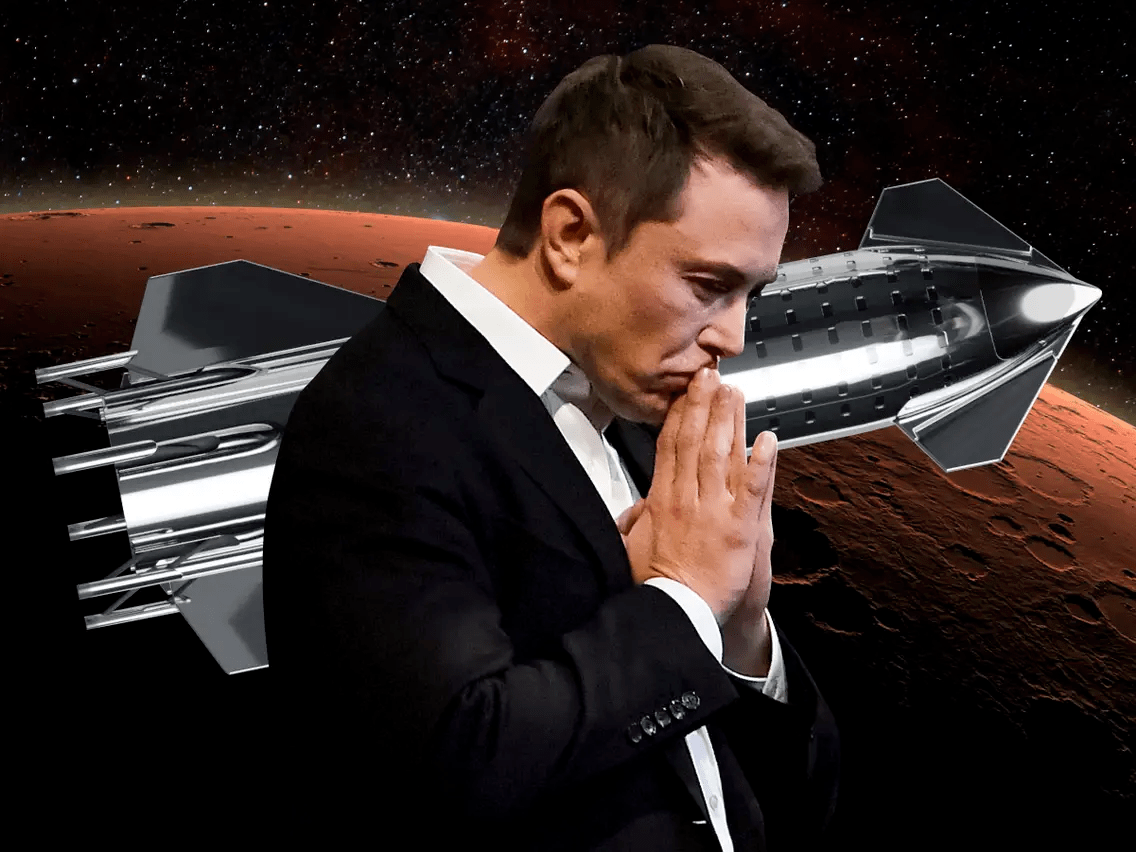
There’s more to settling the Red Planet than just packing a whole lotta people into plus-sized rockets.
In a recent interview, Elon Musk repeated his stated goal of wanting to transport one million people to Mars by 2050. The SpaceX founder says the future of humanity is at stake, which, okay, but the timeline he offers is ludicrous, and here’s why.
Before we plunge into this, I need to make it crystal clear that many of the challenges addressed in this article are not insurmountable. Technological feasibility is not my gripe, nor do I take issue with the desire to colonize the Red Planet, though, as I’ve written before, the colonization of Mars will necessitate the transformation of the human species as we know it.
That the fourth planet from the Sun may host bustling cities at some point in the distant future is possible. My issue with all of this has to do with the stupendously unreasonable timelines under which Musk believes this will happen. In an April 2022 interview with TED curator Chris Anderson, the billionaire rehashed his plan to send one million colonists to Mars by 2050, and he did so while maintaining a remarkably straight face.
A man with a plan
Speaking to a seemingly credulous Anderson, Musk spoke of a herculean Battlestar Galactica-like effort to transport thousands of colonists to Mars with a thousand SpaceX Starship rockets. Musk’s vision remains aligned with a series of tweets from 2020, in which he articulated a plan to build 100 Starships each year over a 10-year period.
Departing in batches, each Starship would leave for Mars during key 30-day windows that open once every 26 months (the launch interval is to take advantage of the Earth-Mars alignment, when the two planets are closest to each other). Should launches begin in 2028, and assuming this intense launch cadence can be realized, Musk figures the Martian city of his dreams, with its million inhabitants, could come to fruition in just 22 years.
For Musk, the lofty figure of one million isn’t just a goal or a prediction—it’s a necessary requirement for sustaining a colony on Mars. The “critical threshold,” he told Anderson, “is if the ships from Earth stop coming for any reason,” which could decide the fate of the Martian colony and ultimately of humanity itself. Musk is claiming a philanthropic motive, saying our inability to colonize Mars and transition to an interplanetary species could serve as a filter that ultimately results in our doom. As he told Anderson, “I think this is important for maximizing the probable lifespan of humanity or consciousness,” but the “probable lifespan of civilizational consciousness as we know it” is like a “small candle in the vast darkness” of the universe—a “delicate” candle that “could just go out.”
But as Musk also told Anderson, life on Mars, “especially in the beginning, will not be luxurious.” Rather, it will be “dangerous, cramped, difficult, hard work,” and “you might not make it back,” he said, adding: “But it’ll be glorious.”
Glorious for Elon Musk, maybe, but certainly not for the colonists relegated to eking out an existence in a supremely hostile and unaccommodating world. Well, assuming they ever get there. The SpaceX CEO told Anderson that “almost anyone can work and save up and eventually have $100,000 and be able to go to Mars if they want,” in reference to the hypothesized cost of each journey. Alternatively, prospective Martians could procure funding from government sponsors or by taking out a loan, Musk said.
Musk, I would argue, is getting way ahead of himself. NASA, by comparison, is hoping to land the first humans on Mars by the late 2030s or early 2040s. A modest human presence would follow, but very slowly and cautiously, with pioneering explorers, scientists, and possibly even some colonists, taking their first tentative baby steps on this hostile, alien world in the years and decades to follow.
These disparate visions of how and when Mars might get colonized are completely out of alignment. It’s as if Musk and NASA inhabit two different realities. And it’s not as if the truth lies somewhere in between. Someone is not just wrong; someone is catastrophically wrong, and that someone is Elon Musk.
Predicated on vaporware
Back-of-the-envelope calculations are fun, but they can lead to erroneous and over-simplified conclusions. A necessary reality check suggests it’s going to take significant time and effort for SpaceX to develop, test, and certify Starship and then build these megarockets in the quantities Musk desires.
To be clear, the fully integrated Starship has not yet reached space. I’m confident SpaceX will eventually have its jumbo rocket, but the heavy launcher, a key element of Musk’s Martian plans, doesn’t yet exist. The current plan is to send a fully integrated, uncrewed Starship on a super-quick orbital spaceflight later this year, but further testing and refinements will be required before the vehicle can be put to functional use.
Importantly, Starship is meant to be reusable, requiring SpaceX to develop an unprecedented “Mechazilla” tower that will somehow catch the rocket during vertical descent and landing. Nothing like this has ever been done, and it could take some time to develop.
Musk is also having to contend with regulators; the Federal Aviation Administration and the U.S. Army Corps of Engineers are concerned about potential environmental damage at the SpaceX launch site in south Texas. As of this writing, SpaceX has not received FAA approval to launch the two-stage Starship at the Boca Chica facility.
Once Starship becomes an actual thing, SpaceX will then have to contend with the daunting challenge of building these rockets en masse. Musk’s hand-waving proclamation that 100 Starships will be built each year is truly ambitious, but I’ll believe it when I see it. The company isn’t currently able to produce its Raptor engines at the pace required to sustain operations. Late last year, Musk said this “Raptor production crisis” threatens a “genuine risk of bankruptcy” if SpaceX cannot launch a Starship rocket once every two weeks. Yet we’re supposed to believe that, in around six years or so, SpaceX will have solved its engine production problems and somehow figured out a way to manufacture Starships in vast quantities—a logistical challenge that will require the steady flow of human labor, materials, propellants, and everything else that will make up this future rocket.
We’re only human
Should SpaceX be capable of transporting so many people to Mars across such a short time frame, there will still exist a tremendous number of challenges to overcome. First and foremost, there’s the human factor to consider. Very simply, our meat suits are not built for space or hostile alien worlds. The Red Planet, with its achingly thin atmosphere, cold temperatures, and non-existent magnetosphere, offers no oxygen to breathe, no water at the surface, and no protection from deadly ionizing radiation.
“Fulfilling Elon Musk’s dream of establishing a self-sustaining colony on Mars entails risks that are far beyond those of sending a small group of humans on a round-trip mission to that planet,” Thomas Lang, a professor at the UCSF Department of Radiology and Biomedical Imaging in San Francisco, explained to me. “The risks of a relatively small Mars mission, which might comprise six-month transits to and from the destination and 18-month sojourns on the surface, are already daunting.”
These challenges, he said, include the maintaining of human physiology at the functional level, protecting colonists from radiation, and dealing with the effects of extreme isolation. Space agencies around the world are currently investigating these risks, and Lang believes we’ll eventually find ways to overcome them.
But even if these risks can be addressed, “establishing a one-million-person colony on Mars” still represents “a leap into the unknown, both in terms of engineering and social evolution,” Lang said. Private firms like SpaceX, and also government agencies, “could eventually build the spacecraft and several of the different supporting technologies like habitats, power generation, and transport,” he said, but those challenges “would be small compared to the challenge of figuring out how to ‘live off the land,’ extracting from Mars the resources needed to support this population.” And if some solutions were to emerge for the on-site production of resources during initial Martian missions, it’s “not clear that it could be successfully scaled up to support a large population,” Lang added.
Barely meeting the bare necessities of life
Jill Sohm, director of the Environment Studies Program at the University of Southern California, thinks of the problem in terms of basic human needs. Humans can “go a few minutes without breathing, a few days without drinking, and a few weeks without eating, so oxygen, water, and food are the bare necessities,” she told me. “Without these, we could not survive, let alone thrive.”
Altering the atmosphere of Mars such that air is breathable within a few decades is clearly not possible. This means colonists will need to live in enclosed environments and have “efficient recycling systems to remove carbon dioxide and generate oxygen” to keep the air breathable, explained Sohm. Providing water to a million people represents another very difficult challenge. Sohm said water can be made with hydrogen, oxygen, and a lot of energy, but those things aren’t readily available on Mars.
“Bringing water that distance from Earth for a large colony is also not possible, so ice would have to be found and melted on Mars. Ice can apparently be found at the poles and perhaps below the surface, but the poles are extremely cold and far away from warmer areas where a colony would likely be built,” Sohm said. “If enough ice could be located and extracted to provide water, again we would need an efficient recycling system that kept it from leaving the colony. All waste would need to be captured and cleaned and put back into circulation.”
It’s a daunting challenge, no doubt. Now, an infrastructure to support a million Martians may eventually be built, but the unspoken suggestion that such an infrastructure will spontaneously and instantly come to exist with the arrival of these thirsty colonists is nothing short of a joke.
Then there’s the question of how to feed them. Sohm estimates that the settlers would require approximately 580 square miles (1,500 square kilometers) of agricultural crop land to feed a colony of that size.
This may not sound like a lot, “but it’s around the size of the city of Los Angeles, where I live,” she said. Colonists would need good quality soil, water, and some form of fertilizer, the latter of which could be produced through wastewater treatment and composting food, she added. Sohm, admitting she’s not an engineer, said she “can’t say how feasible any of this is, but I would say that this assessment makes clear to me that it is a monumental task,” and the hard truth is that “we don’t have a handle on how to replicate on a large scale the natural processes that make our planet so special and habitable.”
To which she added: “I’d point out that all of this would only provide the bare minimum of survival for anyone living in a Mars colony, so we would actually need to ask ourselves the question of what we would consider a good life on Mars that would make it worth it for anyone to take the risk.”
Show me the technology
Serkan Saydam, a mining engineering professor from the University of New South Wales in Australia, says we currently possess the technology required to send people to Mars, but we lack the tech to establish a Martian colony, and we will very likely lack the capacity to sustain a Martian city inhabited by a million people by 2050. “Because to establish an off-Earth city, we will need to establish many other off-Earth operations to construct the city and also support its people,” Saydam said.
Firstly, colonists will need new technologies to extract resources locally, as bringing these required materials from Earth would be “very risky,” “extremely expensive,” and “simply not feasible,” he explained. Colonists will have to source and extract the majority of the required materials on Mars and possibly from nearby asteroids, and also establish beneficiation systems for processing the raw materials and facilities for manufacturing products, he said. These activities will require human labor, which will in turn require water and food, Saydam added.
To allow for these sorts of operations, the technology “must produce more energy and materials” than what’s needed for basic survival on Mars, he said, and these elements will also need to be stored for future use in the colony. Saydam said robots would make these processes easier, but “even our terrestrial mining systems are not fully autonomous yet.”
Saydam provided me with a daunting list of other challenges that will need to be overcome, such as acquiring a deeper geological and geotechnical understanding of Mars, establishing a reliable power supply, creating markets to support the supply chain, reducing risks for business and other stakeholders, forging legal standards and ethical guidelines for the settling of new land, and safeguarding space for peaceful endeavors, among other issues.
Sohm’s earlier point about our inability to replicate natural processes on a large scale reminded me of the failed Biosphere 2 experiments from the 1990s. The two sealed missions demonstrated the formidable challenges of managing closed ecosystems. That a large colony on Mars could survive and thrive without this ability seems doubtful.
Kevin Olsen, a physicist at the University of Oxford who does data analysis for the ExoMars Trace Gas Orbiter mission, said it’s “fundamentally impossible to create a completely closed environment in space.” Air, water, and fuel “will be slowly lost over a long time period, so a colony needs to become a factory and produce these things,” he said.
“This technology is far, far behind the technology of space flight and habitation construction,” explained Olsen. A recent experiment involving NASA’s Perseverance rover, in which oxygen was extracted from the carbon dioxide in the Martian atmosphere, was an “interesting advance,” said Olsen. That’s true, but we are not even remotely close to transforming this proof-of-concept experiment into something practical.
Life, but not as we know it
Earth, unlike Mars, has a strong magnetic field that protects us from ionizing radiation. Our magnetic field is large enough that it also offers protection to the International Space Station, Olsen told me, “so even our long-term stays and radiation experiments in space won’t really prepare us for the dangers of long-term exposure on a cruise to Mars and life on its surface.”
During the recent TED interview, Anderson and Musk discussed a vast array of subterranean tunnels to protect Martian settlers from dangerous levels of radiation. That’ll make for quite the travel brochure, as migrants will essentially be asked to live like moles, making only brief appearances at the surface.
Radiation presents a serious health risk, as does isolation. Indeed, “the level of isolation of this community would be unprecedented, and success in this endeavor would ultimately mean establishing a whole new human civilization,” said Lang, who says we’re still learning about the social dynamics of groups and individuals in the context of isolation.
“We have data from a range of environments, including nuclear subs, polar research stations, the ISS, and the Russian-based Mars 500 experiments,” Lang explained. “However, what about the social dynamics of a large society, so isolated from the Mother Planet, living in a hostile environment? The price that such a society would pay for episodes of social chaos or group psychosis could be immediately fatal. To flourish, such a society would have to maintain a very high level of cohesion across a million people.”
On the topic of social stability, Musk told Anderson that “there’s certainly risk there, and hopefully the people of Mars will be more enlightened, and will not fight amongst each other too much.”
The truth about our future matters
The colonization of Mars, said Olsen, will be a “fundamentally difficult undertaking,” and the desire to do it quickly “makes it even more dangerous.” The space industry, whether private or public, is currently very safety conscious, with governments and the public unwilling to risk the lives of astronauts. “Setting up a colony will go far beyond the experimentation and exploration we are used to in terms of complexity, difficulty, and danger, and we need to be prepared for it to not go smoothly,” he said. “This will be an industrial undertaking, and we’ll need to treat it more like we do Earth’s other high-risk industries such as commercial fishing, mining, or steel working.”
Sohm wonders about the point of it all. Why attempt to build a million-person colony on Mars? “We have a planetary crisis here on Earth,” she said, “and I think we have the moral obligation to spend our time, effort, and money on helping to solve it for all the 7 billion-plus people that live here now, rather than transporting a small fraction of what would surely be some of the most privileged people on Earth to escape its problems and attempt to make a new life on another planet.”
Lang says the construction of a large colony will be a multi-stage process that will take decades to achieve. It’ll also require continuous support from multiple generations of humans.
“I believe that this support would be worthwhile,” Lang told me. “If achieved, the establishment of a self-sustaining society on Mars would be a landmark in human history, and would set the stage for spreading human civilization across the whole solar system.”
Sohm and Lang are both right, and we’d be wise to take care of our business on Earth while also seeking to build an existence outside of our home planet. We can do both, and it’s wrong to suggest these goals are somehow mutually exclusive.
At the same time, it’s important for us be realistic about the future and when we can reasonably expect to do the things that Musk is promising. Musk, whether intentionally or unintentionally, is peddling a false view of humanity’s short-term potential. There are consequences to this at the individual level, as many of Musk’s fans and followers take him at his literal word. The world’s richest man needs to start taking this responsibility far more seriously than he does.
The OnMyWay app is free to download and is currently available on both the App Store for iPhones and Google Play for Android @ OnMyWay; Drive Safe, Get Paid.
Download App Now – https://r.onmyway.com
Sponsors and advertisers can contact the company directly through their website @ www.onmyway.com.











